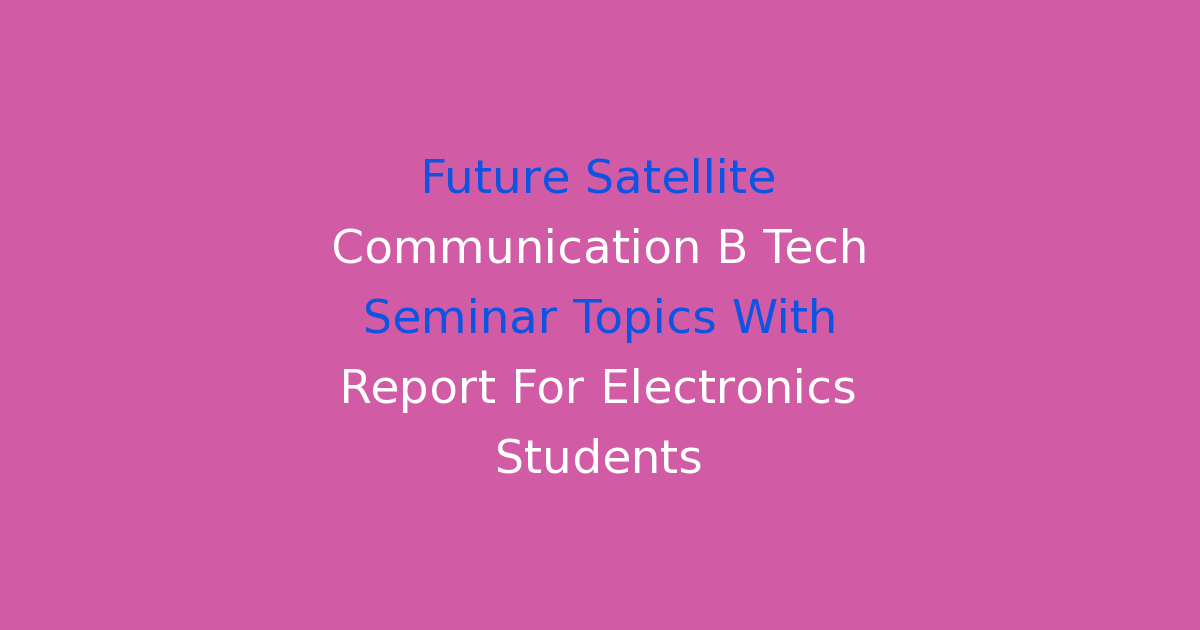Upcoming seminar topics on satellite communication for B Tech electronics students with report preparation.
Future Satellite Communication B Tech Seminar Topics with Report for Electronics Students
Introduction
Satellite communication has played a vital role in connecting people across the globe. From television broadcasting to secure military communications, satellites have become an integral part of our daily lives. As technology continues to advance, the future of satellite communication holds promising opportunities for improvement and innovation. This report aims to explore potential seminar topics for B Tech students in the field of electronics, focusing on the future of satellite communication.
Problem Statement
While satellite communication has made significant advancements over the years, there are still challenges that need to be addressed. The current satellite communication system faces issues such as limited bandwidth, latency, and vulnerability to cyber attacks. Additionally, the cost of launching and maintaining satellites in orbit is a major concern for organizations and governments. As the demand for high-speed and reliable communication services continues to grow, it is crucial to explore new technologies and solutions to enhance the future of satellite communication.
Existing System
The existing satellite communication system relies on geostationary satellites that orbit the Earth at fixed positions. These satellites provide coverage over specific regions but face limitations in terms of bandwidth and signal delay. Communication signals are transmitted from ground stations to satellites, which then relay the signals to other ground stations or users. While this system has been effective for many years, there is a need for more efficient and secure communication solutions.
Disadvantages
Some of the disadvantages of the current satellite communication system include:
1. Limited bandwidth: Current satellites have limited capacity for transmitting data, resulting in slow internet speeds and connectivity issues.
2. Latency: The time it takes for signals to travel between ground stations and satellites can cause delays in communication.
3. Vulnerability to cyber attacks: Satellites are vulnerable to hacking and interference, posing a threat to national security and privacy.
4. High cost: Launching and maintaining satellites in orbit is expensive, making it difficult for smaller organizations to afford satellite communication services.
Proposed System
To address the limitations of the existing system, the proposed future satellite communication system will incorporate advanced technologies such as:
1. Low Earth Orbit (LEO) satellites: LEO satellites orbit closer to the Earth, reducing signal latency and improving bandwidth capabilities.
2. Software-defined networking (SDN): SDN technology allows for flexible and efficient management of communication networks, enhancing security and scalability.
3. Quantum encryption: Quantum encryption technology provides secure communication channels that are immune to hacking and eavesdropping.
4. Artificial intelligence (AI): AI algorithms can optimize satellite communication networks for improved performance and reliability.
Advantages
The advantages of the proposed future satellite communication system include:
1. Increased bandwidth: LEO satellites offer higher bandwidth capacity, enabling faster data transmission and improved connectivity.
2. Low latency: By orbiting closer to the Earth, LEO satellites reduce signal latency for real-time communication applications.
3. Enhanced security: Quantum encryption technology ensures secure communication channels that are resistant to cyber attacks.
4. Cost-effective: The use of advanced technologies such as SDN and AI can optimize satellite communication networks, reducing operational costs.
Features
Some key features of the future satellite communication system include:
1. Global coverage: LEO satellites provide global coverage for seamless communication services across regions.
2. High-speed data transfer: Advanced technology allows for high-speed data transfer rates, supporting bandwidth-intensive applications.
3. Secure communication: Quantum encryption technology ensures end-to-end security for confidential data transmission.
4. Scalability: The system can be easily scaled to accommodate growing communication demands and user requirements.
Conclusion
In conclusion, the future of satellite communication holds great potential for innovation and improvement. By exploring advanced technologies and solutions, we can overcome the limitations of the existing system and pave the way for a more efficient and secure communication network. B Tech students in the field of electronics can benefit from studying seminar topics related to the future of satellite communication, gaining valuable insights into the latest developments in this exciting field. It is imperative for researchers and engineers to continue pushing the boundaries of satellite communication technology, ensuring that we stay connected in an increasingly interconnected world.

